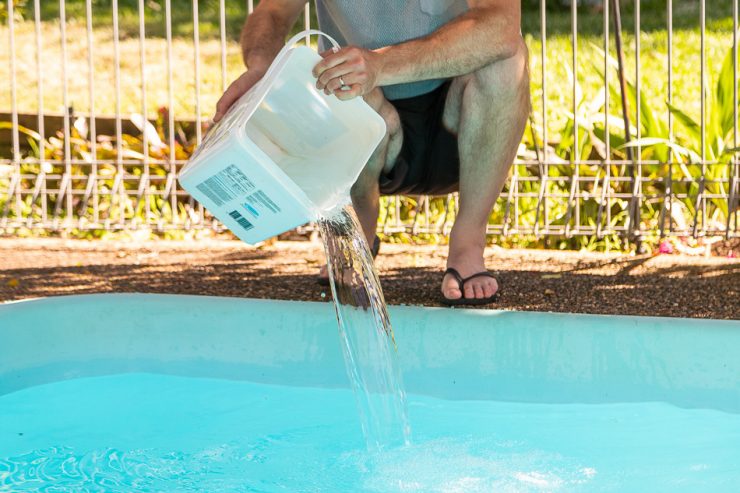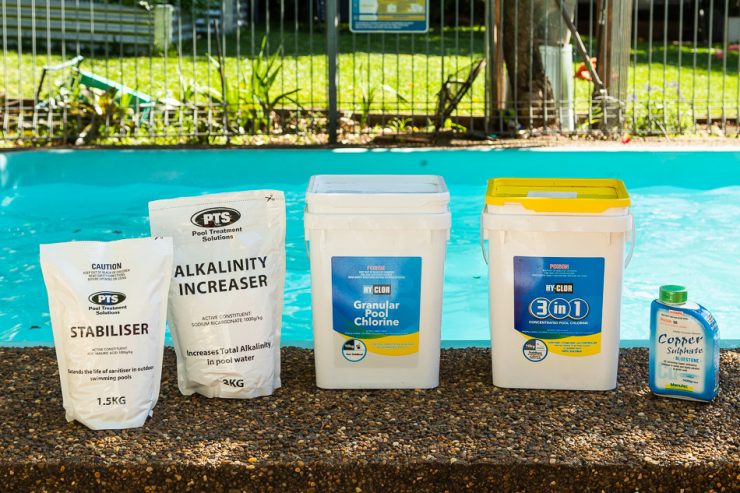So you’ve come up with a great idea. You’re thinking… Wouldn’t it save some time if I could add all the chemicals to my pool at the same time?
Well, this would be a whole lot easier and save time. But is it a good idea to add all the chemicals at once?
You should not add all pool chemicals at the same time. You should also avoid mixing pool chemicals together. Adding chemicals at one time can cause dangerous chemical reactions and serious injuries. In addition, it will make it difficult to balance the pool.
So what happens if you do throw everything in? And what should you do instead?
Let’s find out.

Article Contents
What Happens If You Add Pool Chemicals At Once?
Adding pool chemicals at the same time or all at once is never a good idea. At best, you will have difficulties balancing the pool water and at worst, you may inadvertantly create a fatal explosion.
1) You Will Have See-Sawing Water Chemistry
Pool water chemistry refers to the levels and concentration of pool chemicals in the water. The chemicals in your pool must be in perfect balance together to keep your pool water clean and free from harmful bacteria and viruses.
Each of these chemicals can impact how the other chemicals work. For example, if the stabilizer, also known as cyanuric acid, is too high (above 60 ppm), you will need a higher chlorine level to have the same sanitizing power.
Small Adjustments are Best
When adjusting the water chemistry, it’s much better to make multiple small adjustments and rather than putting everything in at once to make one big adjustment. By adding smaller amounts of chemicals, it gives the chemicals time to mix with the water and start working.
Making smaller adjustments lessens the likelihood of overshooting the chemcial level you were aiming for.
2) The Chemicals Might Explode
Mixing chemicals, especially different chlorine types, or mixing chlorine with acid, should be avoided.
You may remember back in high school science that when two or more chemicals are mixed together, a reaction of some kind occurs. Reactions can produce, heat, sound, light, gas or change the color of chemicals.
Sometimes these reactions are minor and don’t pose any risk. Other times, the reaction can be violent.
Pool shock is a very strong type of chlorine and can create violent and deadly reactions. It mostly comes in the form of calcium hypochlorite (cal-hypo). Whilst it’s good for the pool, it’s also volatile. It should never be stored near other chlorine types or pool chemicals or mixed.
Mixing chlorine with other types of chlorine or other pool chemicals may cause an explosion, fire or produce toxic gas that can cause serious health issues.
Warning: never put a different chlorine type in a chlorine feeder that has had cal-hypo in it. Also don’t add cal-hypo to a chlorine feeder that has been using another chlorine type. It can cause an explosion.
How Long Should You Wait Between Adding Pool Chemicals?
Generally, it’s recommended to wait about 10 minutes between adding each pool chemical. Some pool chemicals like pool salt and cyanuric acid take longer to dissolve in the pool water. The aim is to avoid strong concentrations of chemicals mixing together. Once they are fully diluted with the pool water, it is safe to add additional chemicals.
| Pool Chemical | Time to Wait |
| Cyanuric Acid (Stabilizer or CYA) – granules or powder | Up to 5 days |
| Cyanuric Acid (Stabilizer or CYA) – liquid | 10-30 mins |
| Sodium Bisulfate (pH reducer/ pH Down) | 10-30 mins |
| Muriatic Acid (pH reducer/ pH Down) | 10-30 mins |
| Baking Soda (Sodium Bicarbonate / pH Increaser) | 10-30 mins |
| Soda Ash (Sodium Carbonate / pH Increaser) | 10-30 mins |
| Liquid Chlorine (Sodium Hypochlorite) | 10-30 mins |
| Pool Shock (cal-hypo) | 24 hours |
| Calcium Hypochlorite (cal-hypo) | 24 hours |
Allow 10-30 Mins for Chemicals to Thoroughly Mix
In addition to safety issues, it’s important to leave enough time for the chemical to fully mix through the pool water before retesting the water or adding more. Without waiting long enough, you’re likely to get an incorrect reading.
The water test reading will be too high if you take your test sample from water that has a concentrated amount of chlorine i.e where you’ve just poured chlorine into the water. Or too low, if the chemical hasn’t mixed evenly in the water.
Cyanuric Acid (Stabilizer) can take up to 5 days to dissolve and mix properly.
Some chemicals, like cyanuric acid granules or powder, are very slow to dissolve. CYA (Cyanuric Acid), can take up to 5 days to dissolve. Testing CYA levels before it has dissolved will give you a false reading and you may then make the mistake of adding more.
So in what order should you add the pool chemicals? Let’s find out.
Alternatives to Adding Chemicals At Once
Although it’s tempting to chuck all the chemicals in the water at the same time, there is a much safer and better alternative. And that’s to add the chemicals one at a time and in the correct order.
Here is the correct order to add pool chemicals:
- Alkalinity: chemicals designed to adjust total alkalinity levels go first.
- pH levels: pH up and pH down chemicals go after alkalinity chemicals since the water pH has to be balanced for other chemicals to be effective.
- Calcium hardness
- Stabilizer: CYA and other stabilizing chemicals go next.
- Chlorine
You should know that adding pool chemicals in the wrong order can lead to some of the chemicals becoming ineffective.
To know more about the right order to add pool chemicals, check out this article on our website:
What Order Should You Add Pool Chemicals? (Answered!)

How to Add Pool Chemicals
By now you know not to mix chemicals or add them all at the same time. So what should you do instead?
Add them one at a time waiting 10-30 mins between different chemicals (except for pool shock or cal-hypo – wait 24 hours).
Granular chlorine, pH and alkalinity adjusting chemicals can be dissolved first in a bucket of water. But not at the same time of course. Liquid chlorine and muriatic acid can be poured straight into the pool.
What about adding pool chemicals to the skimmer? Is it OK? Check out our article here to find out: Should You Add Pool Chemicals to the Skimmer?
pH Adjusting Chemicals
You should use sodium bicarbonate or soda ash to increase the pool pH. To lower pool pH, use muriatic acid or sodium bisulfate. These chemicals should first be dissolved in a bucket of pool water.
Then pour the mixture into the pool water while walking along the perimeter of the pool.
Calcium Hardness
To lower the pool calcium hardness, you should drain and refill part of the pool water. To increase the pool calcium hardness, you should add calcium chloride or pool salt to the pool water. Always ensure to measure the right amount of calcium chloride in ratio to the pool water.
Chlorine Stabilizer (Cyanuric Acid)
You can add granular chlorine stabilizer (CYA) to the pool water using the skimmer. Liquid cyanuric acid can be mixed in a bucket of water first and then poured into the pool or skimmer.
It’s best to partially dissolve granular CYA in a bucket of warm water before adding it to the pool skimmer. You must put on a pair of gloves before doing this.
Alkalinity
To adjust the pool alkalinity, you can use baking soda. As usual, you’ll need to dissolve the baking soda in a bucket of water first. Always ensure to use the right amount of baking soda.
This article reveals all you need to know about using baking soda to increase pool alkalinity including expert tips to discover how much baking soda to use.
Pro Tips To Remember While Adding Pool Chemicals To The Pool
- Always test the water chemistry before adding any chemical.
- Never mix chemicals together or all at once
- Always wear chemical-resistant gloves before handling pool chemicals
- Before adding additional chemicals, retest the water before.
- Always add chemicals to water and not the water to the chemical (this is very important).
- Always turn on the pool pump before, during, and after adding pool chemicals. This helps to disperse the chemicals quickly in the water.
Related Reading:
30 Things You Really Shouldn’t Do in a Pool
Using Muriatic Acid To Clear A Green Pool Quickly

